Evaluation of Agricultural Bare Soil Properties Retrieval from Landsat 8, Sentinel-2 and PRISMA Satellite Data
Abstract
:1. Introduction
2. Materials and Methods
2.1. Study Area
2.2. Field and Soil Sampling
2.3. Laboratory Dataset
2.3.1. PRISMA Hyperspectral Data
2.3.2. Sentinel-2 and Landsat 8 Multispectral Data
2.4. Soil Properties’ Estimation
2.4.1. Laboratory and Resampled Spectra
2.4.2. Bare Soil Satellite Spectra
2.4.3. Spatial Assessment of Topsoil Maps
3. Results
3.1. Soil Properties Estimation Using Laboratory and Resampled Spectra
3.2. Soil Properties Estimation Using Bare Soil Satellite Spectra
4. Discussion
5. Conclusions
Author Contributions
Funding
Data Availability Statement
Acknowledgments
Conflicts of Interest
References
- Chabrillat, S.; Ben-Dor, E.; Cierniewski, J.; Gomez, C.; Schmid, T.; van Wesemael, B. Imaging spectroscopy for soil mapping and monitoring. Surv. Geophys. 2019, 40, 361–399. [Google Scholar] [CrossRef] [Green Version]
- Ward, K.J.; Chabrillat, S.; Brell, M.; Castaldi, F.; Spengler, D.; Foerster, S. Mapping soil organic carbon for airborne and simulated enmap imagery using the LUCAS soil database and a Local PLSR. Remote Sens. 2020, 12, 3451. [Google Scholar] [CrossRef]
- Omran, E.S.E. Rapid prediction of soil mineralogy using imaging spectroscopy. Eurasian Soil Sci. 2017, 50, 597–612. [Google Scholar] [CrossRef]
- Yuan, J.; Wang, X.; Yan, C.; Chen, S.; Wang, S.; Zhang, J.; Xu, Z.; Ju, X.; Ding, N.; Dong, Y.; et al. Wavelength selection for estimating soil organic matter contents through the radiative transfer model. IEEE Access 2020, 8, 176286–176293. [Google Scholar] [CrossRef]
- Zeng, W.; Xu, C.; Huang, J.; Wu, J.; Tuller, M. Predicting near-surface moisture content of saline soils from near-infrared reflectance spectra with a modified Gaussian model. Soil Sci. Soc. Am. J. 2016, 80, 1496–1506. [Google Scholar] [CrossRef]
- Sadeghi, M.; Babaeian, E.; Tuller, M.; Jones, S.B. Particle size effects on soil reflectance explained by an analytical radiative transfer model. Remote Sens. Environ. 2018, 210, 375–386. [Google Scholar] [CrossRef]
- Norouzi, S.; Sadeghi, M.; Liaghat, A.; Tuller, M.; Jones, S.B.; Ebrahimian, H. Information depth of NIR/SWIR soil reflectance spectroscopy. Remote Sens. Environ. 2021, 256, 112315. [Google Scholar] [CrossRef]
- Gomez, C.; Oltra-Carrió, R.; Bacha, S.; Lagacherie, P.; Briottet, X. Evaluating the sensitivity of clay content prediction to atmospheric effects and degradation of image spatial resolution using hyperspectral VNIR/SWIR imagery. Remote Sens. Environ. 2015, 164, 1–15. [Google Scholar] [CrossRef]
- Lagacherie, P.; Baret, F.; Feret, J.B.; Madeira Netto, J.; Robbez-Masson, J.M. Estimation of soil clay and calcium carbonate using laboratory, field and airborne hyperspectral measurements. Remote Sens. Environ. 2008, 112, 825–835. [Google Scholar] [CrossRef]
- Mutanga, O.; Skidmore, A.K.; Kumar, L.; Ferwerda, J. Estimating tropical pasture quality at canopy level using band depth analysis with continuum removal in the visible domain. Int. J. Remote Sens. 2007, 26, 1093–1108. [Google Scholar] [CrossRef]
- Gomez, C.; Viscarra Rossel, R.A.; McBratney, A.B. Soil organic carbon prediction by hyperspectral remote sensing and field Vis-NIR spectroscopy: An Australian case study. Geoderma 2008, 146, 403–411. [Google Scholar] [CrossRef]
- Liu, S.; Shen, H.; Chen, S.; Zhao, X.; Biswas, A.; Jia, X.; Shi, Z.; Fang, J. Estimating forest soil organic carbon content using Vis-NIR spectroscopy: Implications for large-scale soil carbon spectroscopic assessment. Geoderma 2019, 348, 37–44. [Google Scholar] [CrossRef]
- Viscarra Rossel, R.A.; Lee, J.; Behrens, T.; Luo, Z.; Baldock, J.; Richards, A.; Viscarra Rossel, R.A.; Lee, J.; Behrens, T.; Luo, Z.; et al. Continental-scale soil carbon composition and vulnerability modulated by regional environmental controls. Nat. Geosci. 2019, 12, 547–552. [Google Scholar] [CrossRef]
- Gholizadeh, A.; Saberioon, M.; Viscarra Rossel, R.A.; Boruvka, L.; Klement, A. Spectroscopic measurements and imaging of soil colour for field scale estimation of soil organic carbon. Geoderma 2020, 357, 113972. [Google Scholar] [CrossRef]
- Gholizadeh, A.; Neumann, C.; Chabrillat, S.; van Wesemael, B.; Castaldi, F.; Borůvka, L.; Sanderman, J.; Klement, A.; Hohmann, C. Soil organic carbon estimation using VNIR–SWIR spectroscopy: The effect of multiple sensors and scanning conditions. Soil Tillage Res. 2021, 211, 105017. [Google Scholar] [CrossRef]
- Demattê, J.A.M.; Dotto, A.C.; Paiva, A.F.S.; Sato, M.V.; Dalmolin, R.S.D.; de Araújo, M.d.S.B.; da Silva, E.B.; Nanni, M.R.; ten Caten, A.; Noronha, N.C.; et al. The Brazilian soil spectral library (BSSL): A general view, application and challenges. Geoderma 2019, 354, 113793. [Google Scholar] [CrossRef]
- Ben-Dor, E. Quantitative remote sensing of soil properties. Adv. Agron. 2002, 75, 173–243. [Google Scholar] [CrossRef]
- Shi, P.; Castaldi, F.; van Wesemael, B.; Van Oost, K. Large-scale, high-resolution mapping of soil aggregate stability in croplands using APEX hyperspectral imagery. Remote. Sens. 2020, 12, 666. [Google Scholar] [CrossRef] [Green Version]
- Castaldi, F.; Chabrillat, S.; Jones, A.; Vreys, K.; Bomans, B.; van Wesemael, B. Soil organic carbon estimation in croplands by hyperspectral remote APEX data using the LUCAS topsoil database. Remote. Sens. 2018, 10, 153. [Google Scholar] [CrossRef] [Green Version]
- Castaldi, F.; Palombo, A.; Santini, F.; Pascucci, S.; Pignatti, S.; Casa, R. Evaluation of the potential of the current and forthcoming multispectral and hyperspectral imagers to estimate soil texture and organic carbon. Remote Sens. Environ. 2016, 179, 54–65. [Google Scholar] [CrossRef]
- Castaldi, F.; Palombo, A.; Pascucci, S.; Pignatti, S.; Santini, F.; Casa, R. Reducing the influence of soil moisture on the estimation of clay from hyperspectral data: A case study using simulated PRISMA data. Remote Sens. 2015, 7, 15561–15582. [Google Scholar] [CrossRef] [Green Version]
- Dangal, S.R.S.; Sanderman, J.; Wills, S.; Ramirez-Lopez, L. Accurate and precise prediction of soil properties from a large mid-infrared spectral library. Soil Syst. 2019, 3, 11. [Google Scholar] [CrossRef] [Green Version]
- Guerrero, C.; Zornoza, R.; Gómez, I.; Mataix-Beneyto, J. Spiking of NIR regional models using samples from target sites: Effect of model size on prediction accuracy. Geoderma 2010, 158, 66–77. [Google Scholar] [CrossRef]
- Sankey, J.B.; Brown, D.J.; Bernard, M.L.; Lawrence, R.L. Comparing local vs. global visible and near-infrared (VisNIR) diffuse reflectance spectroscopy (DRS) calibrations for the prediction of soil clay, organic C and inorganic C. Geoderma 2008, 148, 149–158. [Google Scholar] [CrossRef] [Green Version]
- Wetterlind, J.; Stenberg, B. Near-infrared spectroscopy for within-field soil characterization: Small local calibrations compared with national libraries spiked with local samples. Eur. J. Soil Sci. 2010, 61, 823–843. [Google Scholar] [CrossRef] [Green Version]
- Pouladi, N.; Møller, A.B.; Tabatabai, S.; Greve, M.H. Mapping soil organic matter contents at field level with Cubist, random forest and kriging. Geoderma 2019, 342, 85–92. [Google Scholar] [CrossRef]
- Viscarra Rossel, R.A.; Behrens, T.; Ben-Dor, E.; Brown, D.J.; Demattê, J.A.M.; Shepherd, K.D.; Shi, Z.; Stenberg, B.; Stevens, A.; Adamchuk, V.; et al. A global spectral library to characterize the world’s soil. Earth Sci. Rev. 2016, 155, 198–230. [Google Scholar] [CrossRef] [Green Version]
- Ben Dor, E.; Ong, C.; Lau, I.C. Reflectance measurements of soils in the laboratory: Standards and protocols. Geoderma 2015, 245–246, 112–124. [Google Scholar] [CrossRef]
- Adeline, K.R.M.; Gomez, C.; Gorretta, N.; Roger, J.-M. Predictive ability of soil properties to spectral degradation from laboratory Vis-NIR spectroscopy data. Geoderma 2017, 288, 143–153. [Google Scholar] [CrossRef] [Green Version]
- Dematte, J.A.M.; Fiorio, P.R.; Ben-Dor, E. Estimation of soil properties by orbital and laboratory reflectance means and its relation with soil classification. Open Remote Sens. J. 2009, 2, 12–23. [Google Scholar] [CrossRef]
- Castaldi, F. Sentinel-2 and landsat-8 multi-temporal series to estimate topsoil properties on croplands. Remote Sens. 2021, 13, 3345. [Google Scholar] [CrossRef]
- Gholizadeh, A.; Žižala, D.; Saberioon, M.; Borůvka, L. Soil organic carbon and texture retrieving and mapping using proximal, airborne and sentinel-2 spectral imaging. Remote Sens. Environ. 2018, 218, 89–103. [Google Scholar] [CrossRef]
- Castaldi, F.; Hueni, A.; Chabrillat, S.; Ward, K.; Buttafuoco, G.; Bomans, B.; Vreys, K.; Brell, M.; van Wesemael, B. Evaluating the capability of the sentinel 2 data for soil organic carbon prediction in croplands. ISPRS J. Photogramm. Remote Sens. 2019, 147, 267–282. [Google Scholar] [CrossRef]
- Dvorakova, K.; Heiden, U.; van Wesemael, B. Sentinel-2 exposed soil composite for soil organic carbon prediction. Remote Sens. 2021, 13, 1791. [Google Scholar] [CrossRef]
- Ben-Dor, E.; Chabrillat, S.; Demattê, J.A.M.; Taylor, G.R.; Hill, J.; Whiting, M.L.; Sommer, S. Using imaging spectroscopy to study soil properties. Remote Sens. Environ. 2009, 113, S38–S55. [Google Scholar] [CrossRef]
- Clark, R.N.; Roush, T.L. Reflectance spectroscopy: Quantitative analysis techniques for remote sensing applications. J. Geophys. Res. 1984, 89, 6329–6340. [Google Scholar] [CrossRef]
- Sun, W.; Liu, S.; Zhang, X.; Li, Y. Estimation of soil organic matter content using selected spectral subset of hyperspectral data. Geoderma 2022, 409, 115653. [Google Scholar] [CrossRef]
- Mulder, V.L.; de Bruin, S.; Schaepman, M.E.; Mayr, T.R. The use of remote sensing in soil and terrain mapping—A review. Geoderma 2011, 162, 1–19. [Google Scholar] [CrossRef]
- Casa, R.; Castaldi, F.; Pascucci, S.; Palombo, A.; Pignatti, S. A comparison of sensor resolution and calibration strategies for soil texture estimation from hyperspectral remote sensing. Geoderma 2013, 197–198, 17–26. [Google Scholar] [CrossRef]
- Steinberg, A.; Chabrillat, S.; Stevens, A.; Segl, K.; Foerster, S. Prediction of common surface soil properties based on Vis-NIR airborne and simulated EnMAP imaging spectroscopy data: Prediction accuracy and influence of spatial resolution. Remote Sens. 2016, 8, 613. [Google Scholar] [CrossRef] [Green Version]
- Pepe, M.; Pompilio, L.; Gioli, B.; Busetto, L.; Boschetti, M. Detection and classification of non-photosynthetic vegetation from PRISMA hyperspectral data in croplands. Remote Sens. 2020, 12, 3903. [Google Scholar] [CrossRef]
- Hank, T.; Berger, K.; Wocher, M.; Danner, M.; Mauser, W. Introducing the potential of the EnMAP-box for agricultural applications using DESIS and PRISMA data. In Proceedings of the 41 IEEE International Geoscience and Remote Sensing Symposium (IGARSS 2021), Brussels, Belgium, 11–16 July 2021; IEEE: Piscataway Township, NJ, USA, 2021; pp. 467–470, ISBN 9781665403696. [Google Scholar]
- Napoli, R.; Paolanti, M.; di Ferdinando, S. Atlante Dei Suoli Del Lazio; ARSIAL Regione Lazio: Rome, Italy, 2019; ISBN 978-88-904841-2-4. [Google Scholar]
- Cassi, F.; Viviano, L. I Suoli Della Basilicata—Carta Pedologica Della Regione Basilicata in Scala 1:250.000. Regione Basilicata—Dip. Agricoltura e Sviluppo Rurale. Direzione Generale. Reg. Basilicata-Dip. Agric. Svilup. Rurale. Dir. Gen: Potenza, Italy, 2006; p. 343. [Google Scholar]
- Schiavon, E.; Taramelli, A.; Tornato, A.; Pierangeli, F. Monitoring environmental and climate goals for european agriculture: User perspectives on the optimization of the Copernicus evolution offer. J. Environ. Manag. 2021, 296. [Google Scholar] [CrossRef]
- Coppo, P.; Brandani, F.; Faraci, M.; Sarti, F.; Dami, M.; Chiarantini, L.; Ponticelli, B.; Giunti, L.; Fossati, E.; Cosi, M. Leonardo spaceborne infrared payloads for Earth observation: SLSTRs for Copernicus sentinel 3 and PRISMA hyperspectral camera for PRISMA satellite. Appl. Opt. 2020, 59, 6888. [Google Scholar] [CrossRef]
- Loizzo, R.; Daraio, M.; Guarini, R.; Longo, F.; Lorusso, R.; Dini, L.; Lopinto, E. PRISMA mission status and perspective. In Proceedings of the IEEE International Geoscience and Remote Sensing Symposium (IGARSS), Yokohama, Japan, 28 July–2 August 2019; pp. 4503–4506. [Google Scholar]
- Cogliati, S.; Sarti, F.; Chiarantini, L.; Cosi, M.; Lorusso, R.; Lopinto, E.; Miglietta, F.; Genesio, L.; Guanter, L.; Damm, A.; et al. The PRISMA imaging spectroscopy mission: Overview and first performance analysis. Remote Sens. Environ. 2021, 262. [Google Scholar] [CrossRef]
- Wold, S.; Sjöström, M.; Eriksson, L. PLS-regression: A basic tool of chemometrics. Chemom. Intell. Lab. Syst. 2001, 58, 109–130. [Google Scholar] [CrossRef]
- Quinlan, J.R. Learning with continuous classes. In Proceedings of the 5th Australian Joint Conference on Artificial Intelligence, Hobart, Australia, 16–18 November 1992; Word Scientific: Singapore, 1992; Volume 92, pp. 343–348. [Google Scholar]
- Savitzky, A.; Golay, M.J.E. Smoothing and differentiation of data by simplified least squares procedures. Anal. Chem. 1964, 36, 1627–1639. [Google Scholar] [CrossRef]
- Barnes, R.; Dhanoa, M.; Lister, S. Standard normal variate transformation and de-trending of near-infrared diffuse reflectance spectra. Appl. Spectrosc. 1989, 43, 772–777. [Google Scholar] [CrossRef]
- Kuhn, M. Caret: Classification and Regression Training. R Package Version 6.0-90. 2010. Available online: https://CRAN.R-project.org/package=caret (accessed on 15 December 2021).
- Bellon-Maurel, V.; Fernandez-Ahumada, E.; Palagos, B.; Roger, J.M.; McBratney, A. Critical review of chemometric indicators commonly used for assessing the quality of the prediction of soil attributes by NIR spectroscopy. TrAC Trends Anal. Chem. 2010, 29, 1073–1081. [Google Scholar] [CrossRef]
- Lehnert, L.W.; Meyer, H.; Obermeier, W.A.; Silva, B.; Regeling, B.; Thies, B.; Bendix, J. Hyperspectral data analysis in R: The hsdar package. J. Stat. Softw. 2019, 89, 1–23. [Google Scholar] [CrossRef] [Green Version]
- Chabrillat, S.; Eisele, A.; Guillaso, S.; Rogaß, C.; Ben-Dor, E.; Kaufmann, H. Hysoma: An easy-to-use software interface for soil mapping applications of hyperspectral imagery. In Proceedings of the 7th EARSeL SIG Imaging Spectroscopy Workshop, Edinburgh, Scotland, UK, 11–13 April 2011; pp. 11–13. [Google Scholar]
- Nagler, P.L.; Inoue, Y.; Glenn, E.P.; Russ, A.L.; Daughtry, C.S.T. Cellulose absorption index (CAI) to quantify mixes soil-plant litter scenes. Remote Sens. Environ. 2003, 87, 310–325. [Google Scholar] [CrossRef]
- Williams, B.G.; Hoey, D. The use of electromagnetic induction to detect the spatial variability of the salt and clay contents of soils. Soil Res. 1987, 25, 21–27. [Google Scholar] [CrossRef]
- Sudduth, K.A.; Kitchen, N.R.; Wiebold, W.J.; Batchelor, W.D.; Bollero, G.A.; Bullock, D.G.; Clay, D.E.; Palm, H.L.; Pierce, F.J.; Schuler, R.T.; et al. Relating apparent electrical conductivity to soil properties across the North-Central USA. Comput. Electron. Agric. 2005, 46, 263–283. [Google Scholar] [CrossRef]
- Triantafilis, J.; Lesch, S.M. Mapping clay content variation using electromagnetic induction techniques. Comput. Electron. Agric. 2005, 46, 203–237. [Google Scholar] [CrossRef]
- Werban, U.; Kuka, K.; Merbach, I. Correlation of electrical resistivity, electrical conductivity and soil parameters at a long-term fertilization experiment. Near Surf. Geophys. 2009, 7, 5–14. [Google Scholar] [CrossRef]
- Casa, R.; Castaldi, F.; Pascucci, S.; Basso, B.; Pignatti, S. Geophysical and hyperspectral data fusion techniques for in-field estimation of soil properties. Vadose Zone J. 2013, 12, 1–10. [Google Scholar] [CrossRef]
- Dutilleul, P.; Clifford, P.; Richardson, S.; Hemon, D. Modifying the t test for assessing the correlation between two spatial processes. Biometrics 1993, 49, 305. [Google Scholar] [CrossRef]
- Clifford, P.; Richardson, S.; Hemon, D. Assessing the significance of the correlation between two spatial processes. Biometrics 1989, 45, 123. [Google Scholar] [CrossRef]
- Vallejos, R.; Osorio, F.; Bevilacqua, M. Spatial Relationships between Two Georeferenced Variables: With Applications in R; Springer Nature: Berlin/Heidelberg, Germany, 2020. [Google Scholar] [CrossRef]
- Clark, R.N.; Rencz, A.N. Spectroscopy of rocks and minerals, and principles of spectroscopy. Man. Remote Sens. 1999, 3, 3–58. [Google Scholar]
- Fongaro, C.T.; Demattê, J.A.M.; Rizzo, R.; Safanelli, J.L.; Mendes, W.S.; Dotto, A.C.; Vicente, L.E.; Franceschini, M.H.D.; Ustin, S.L. Improvement of clay and sand quantification based on a novel approach with a focus on multispectral satellite images. Remote Sens. 2018, 10, 1555. [Google Scholar] [CrossRef] [Green Version]
- Ben-Dor, E.; Inbar, Y.; Chen, Y. The reflectance spectra of organic matter in the visible near-infrared and short wave infrared region (400–2500 nm) during a controlled decomposition process. Remote Sens. Environ. 1997, 61, 1–15. [Google Scholar] [CrossRef]
- Castaldi, F.; Chabrillat, S.; Chartin, C.; Genot, V.; Jones, A.R.; van Wesemael, B. Estimation of soil organic carbon in arable soil in Belgium and Luxembourg with the LUCAS topsoil database. Eur. J. Soil Sci. 2018, 69, 592–603. [Google Scholar] [CrossRef]
- Chen, S.; Arrouays, D.; Leatitia Mulder, V.; Poggio, L.; Minasny, B.; Roudier, P.; Libohova, Z.; Lagacherie, P.; Shi, Z.; Hannam, J.; et al. Digital mapping of GlobalSoilMap soil properties at a broad scale: A review. Geoderma 2022, 409, 115567. [Google Scholar] [CrossRef]
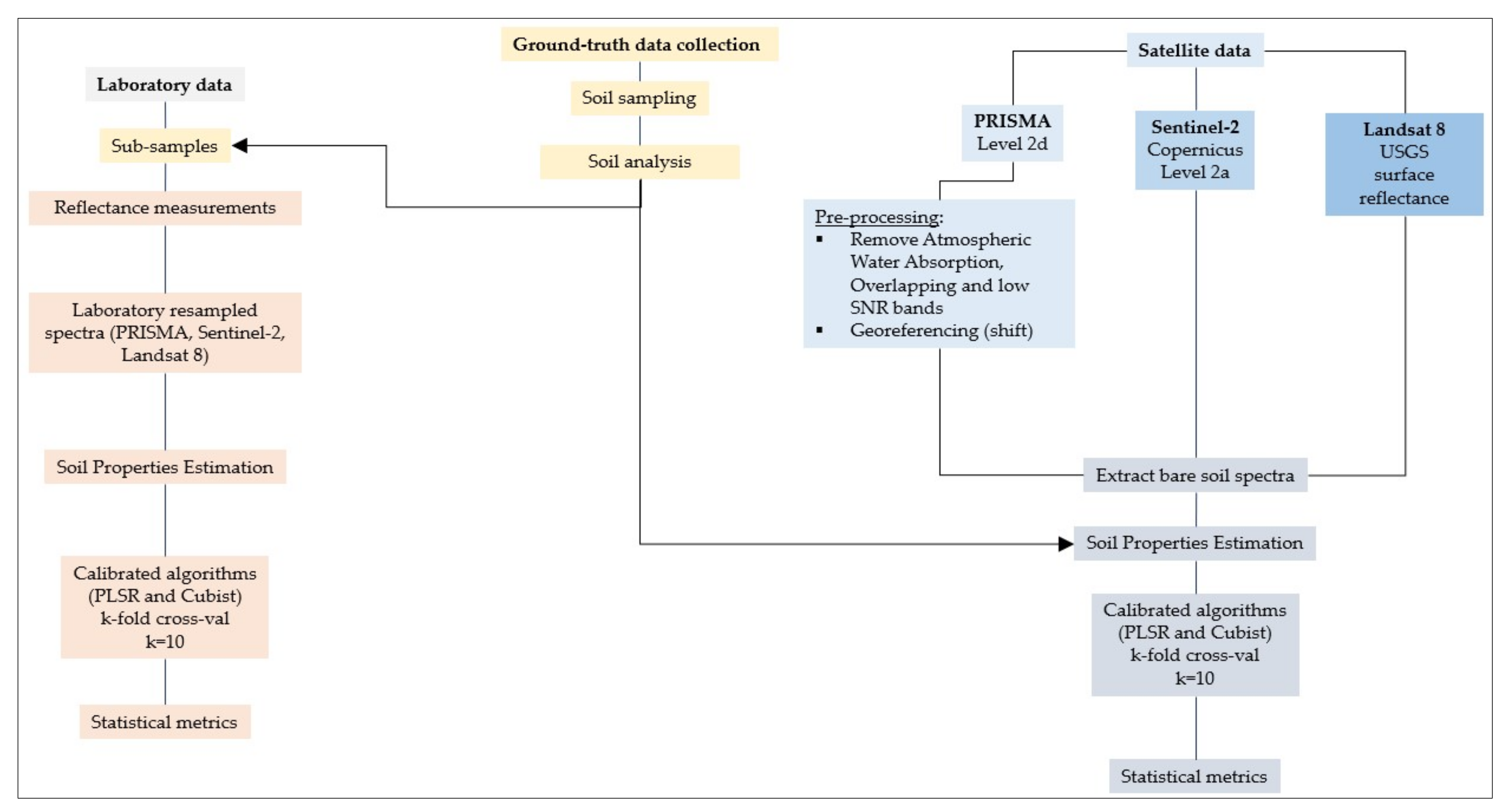


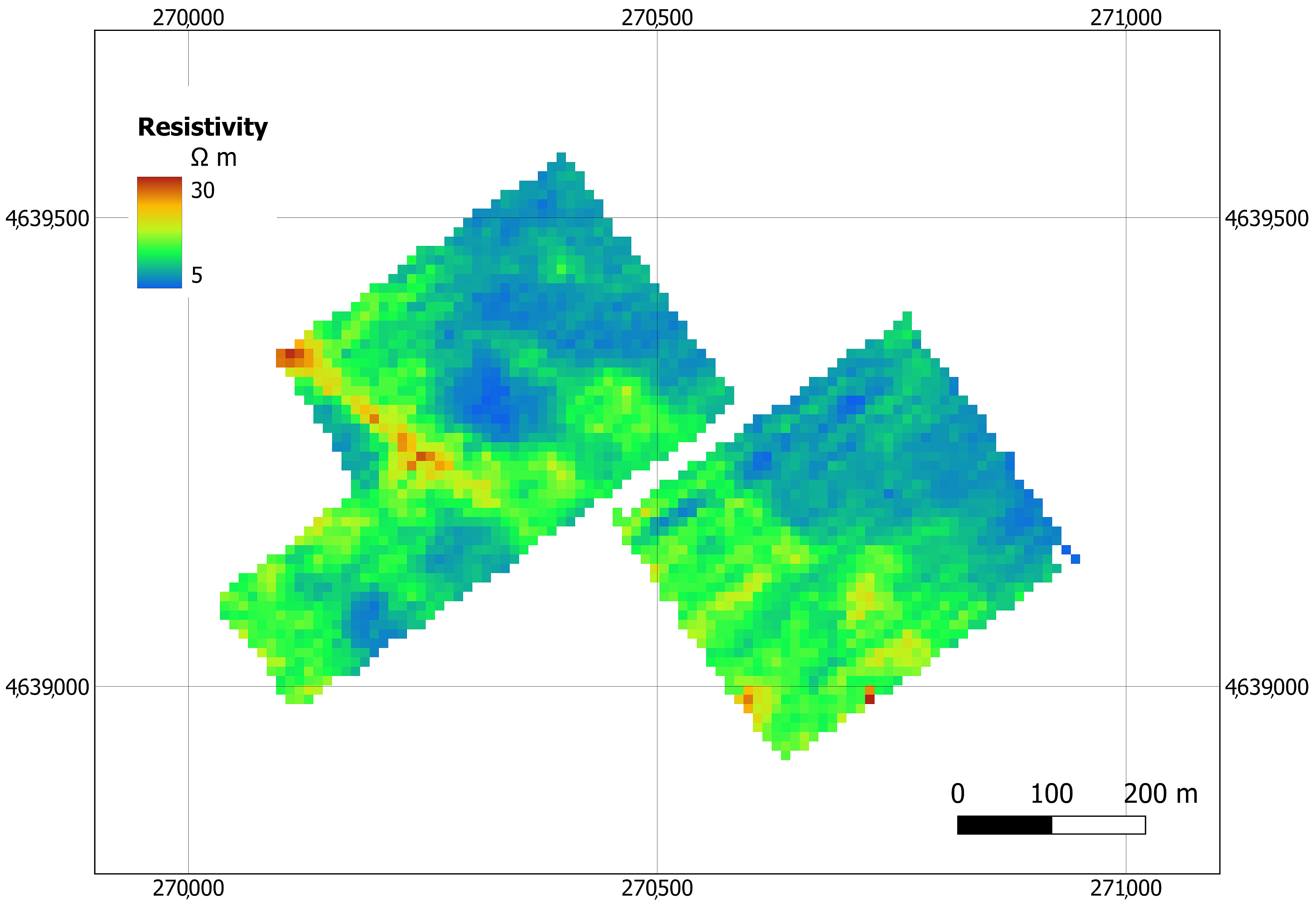
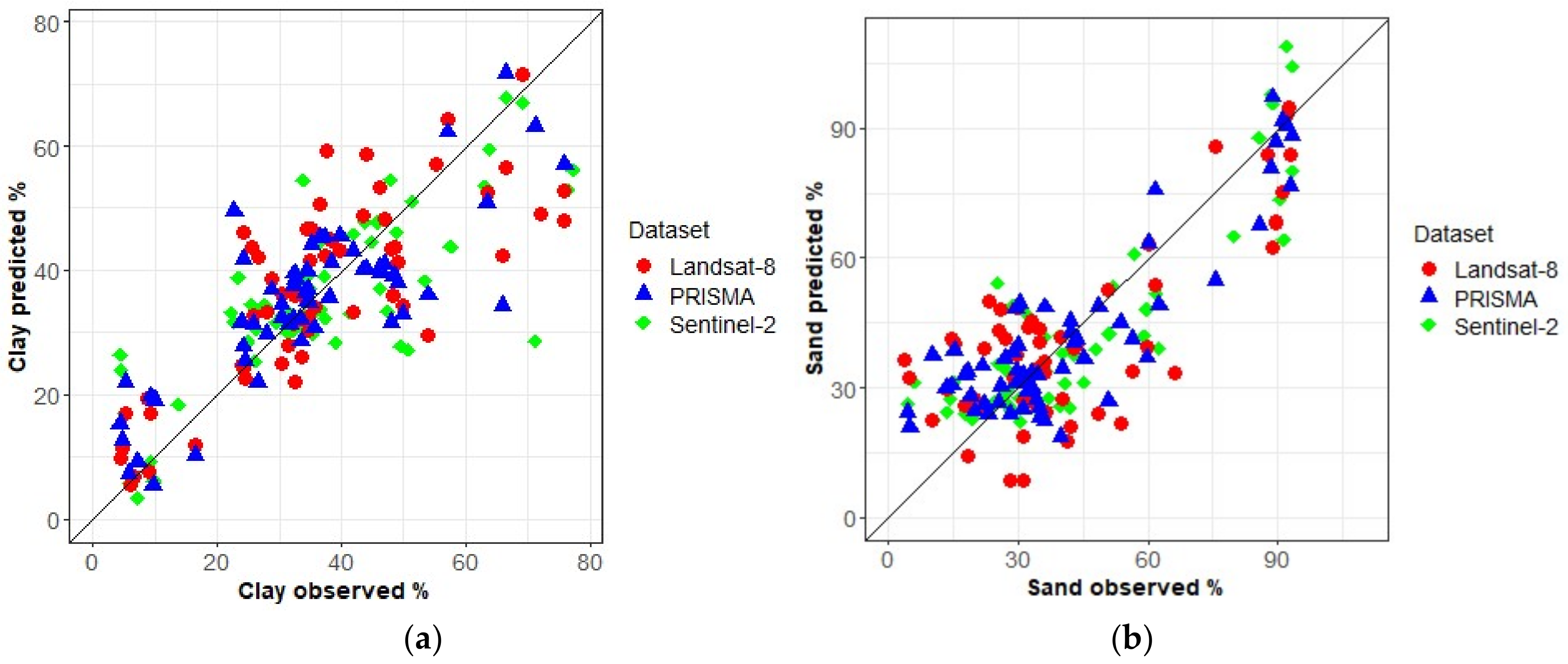
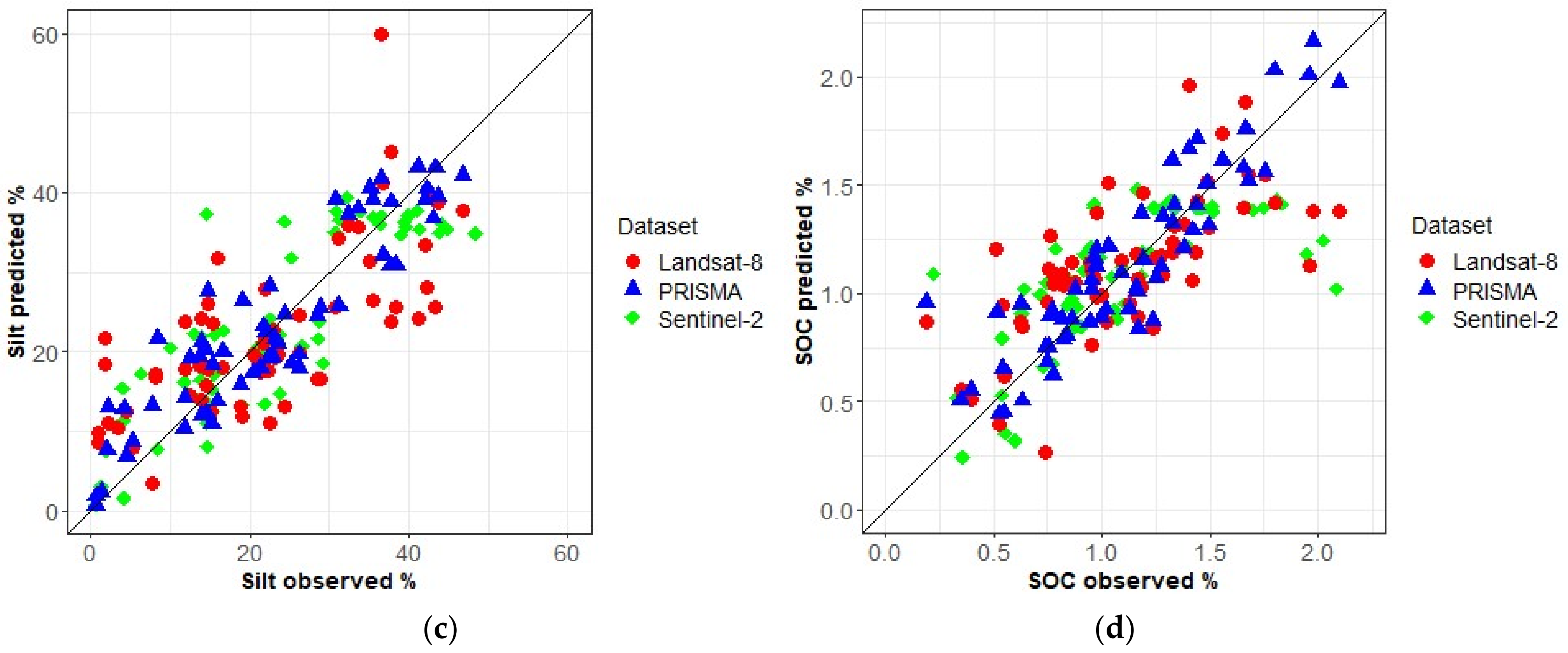

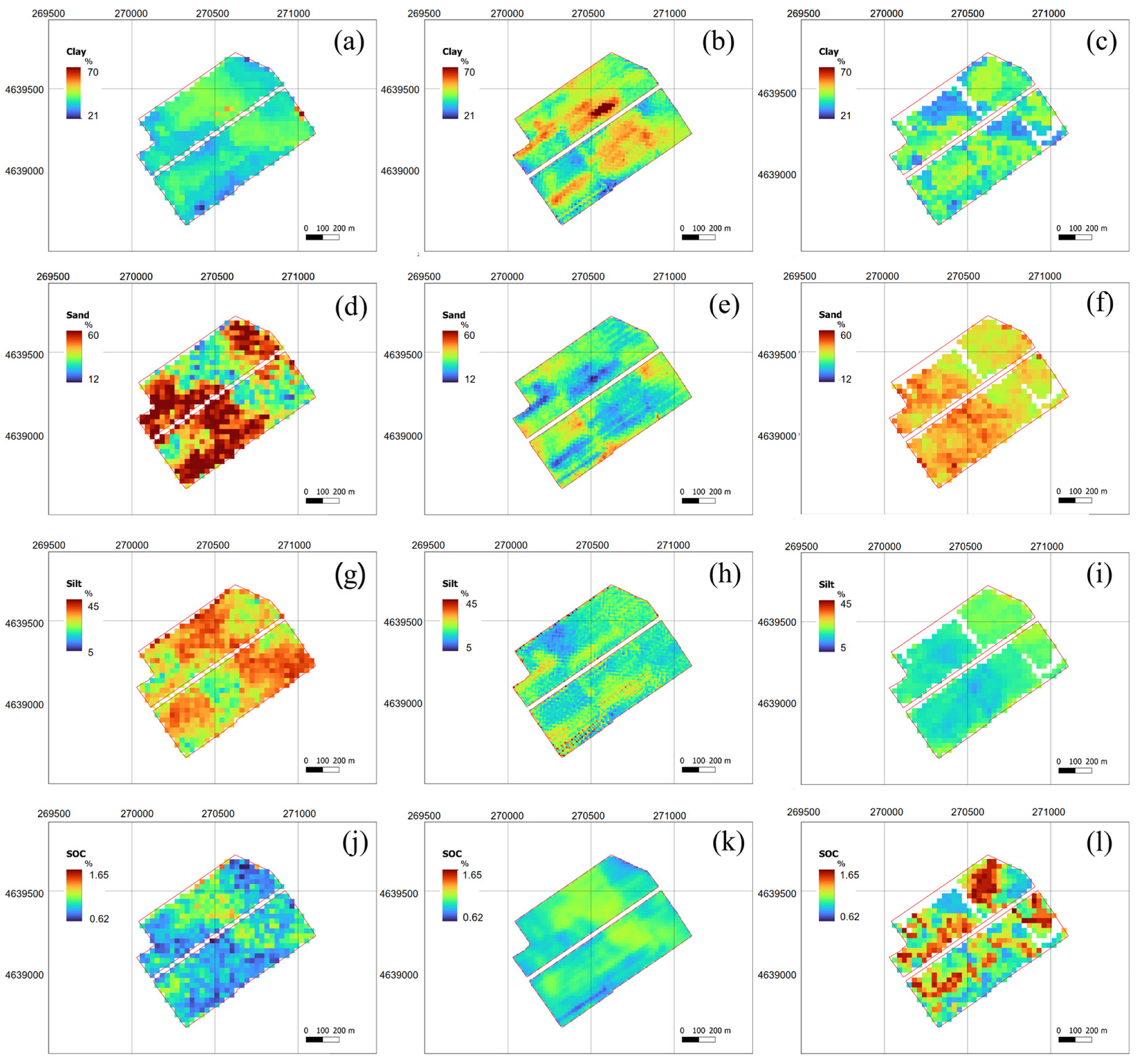

| Maccarese | Pignola | ||||
|---|---|---|---|---|---|
| ESU (PRISMA, Landsat 8) | Sub-ESU (Sentinel-2) | ESU (PRISMA, Landsat 8) | Sub-ESU (Sentinel-2) | ||
| Clay (%) | Min | 4.37 | 4.50 | 23.88 | 22.3 |
| Max | 75.93 | 77.32 | 53.98 | 53.48 | |
| Mean | 37.56 | 37.33 | 33.99 | 33.78 | |
| Std | 21.10 | 21.13 | 7.28 | 7.20 | |
| Silt (%) | Min | 1.05 | 0.70 | 30.85 | 30.77 |
| Max | 28.89 | 29.26 | 46.82 | 48.45 | |
| Mean | 15.21 | 15.39 | 38.26 | 38.32 | |
| Std | 8.20 | 8.48 | 4.70 | 5.23 | |
| Sand (%) | Min | 3.51 | 4.47 | 14.78 | 14.28 |
| Max | 93.04 | 93.47 | 36.07 | 39.68 | |
| Mean | 47.23 | 47.27 | 27.75 | 27.9 | |
| Std | 26.88 | 26.86 | 6.53 | 7.05 | |
| SOC (%) | Min | 0.18 | 0.22 | 0.96 | 0.96 |
| Max | 2.09 | 2.08 | 1.80 | 1.83 | |
| Mean | 0.95 | 0.95 | 1.44 | 1.44 | |
| Std | 0.41 | 0.40 | 0.23 | 0.25 | |
| VNIR | SWIR | PAN | |
|---|---|---|---|
| Spectral range | 400–1010 nm | 920–2500 nm | 400–750 |
| Spectral resolution | 12 nm | 12 nm | |
| Spectral bands | 66 | 171 | 1 |
| SNR | >200:1 on 400–1000 nm >600:1 @ 650 nm | >200:1 in 1000–1750 nm >400:1 @ 1550 nm >100:1 in 1950–2350 nm >200:1 @ 2100 nm | >240:1 |
| MTF | @ Nyquist Frequency > 0.3 | @ Nyquist Frequency > 0.3 | @ Nyquist Frequency > 0.2 |
| Swath width | 30 km; 2.77° | ||
| Spatial resolution | 30 m | 30 m | 5 m |
| Telescope aperture | 210 mm (diameter) | ||
| Orbital altitude | 620 km | ||
| Study Area | PRISMA | Sentinel-2 | Landsat 8 | |
|---|---|---|---|---|
| Maccarese | Calibration | 7 November 2019 | 7 November 2019 | 1 November 2019 |
| 8 February 2020 | 8 February 2020 | 5 February 2020 | ||
| 20 October 2020 | 20 October 2020 | 18 October 2020 | ||
| Mapping | 17 May 2021 | 15 May 2021 | 20 April 2018 | |
| Pignola | Calibration | 23 August 2021 | 22 August 2021 | 20 August 2021 |
| Variable | Resampling Type | Model | RMSE (%) | RPIQ | RPD | R2 |
|---|---|---|---|---|---|---|
| Clay | LAB PRISMA | PLSR | 4.37 | 4.87 | 4.12 | 0.92 |
| LAB S2 | Cubist | 5.34 | 3.99 | 3.37 | 0.87 | |
| LAB L8 | Cubist | 6.48 | 3.29 | 2.78 | 0.80 | |
| LAB | PLSR | 4.77 | 4.46 | 3.78 | 0.90 | |
| Silt | LAB PRISMA | PLSR | 3.93 | 4.88 | 3.29 | 0.90 |
| LAB S2 | Cubist | 4.21 | 4.56 | 3.08 | 0.92 | |
| LAB L8 | Cubist | 5.41 | 3.54 | 2.39 | 0.86 | |
| LAB | PLSR | 3.84 | 5.00 | 3.36 | 0.92 | |
| Sand | LAB PRISMA | PLSR | 6.79 | 3.80 | 3.58 | 0.93 |
| LAB S2 | Cubist | 7.76 | 3.32 | 3.13 | 0.92 | |
| LAB L8 | Cubist | 9.54 | 2.70 | 2.55 | 0.85 | |
| LAB | PLSR | 6.80 | 3.79 | 3.58 | 0.93 | |
| Organic Carbon | LAB PRISMA | PLSR | 0.23 | 2.59 | 1.81 | 0.77 |
| LAB S2 | PLSR | 0.27 | 2.21 | 1.54 | 0.74 | |
| LAB L8 | Cubist | 0.35 | 1.70 | 1.22 | 0.50 | |
| LAB | PLSR | 0.23 | 2.59 | 1.81 | 0.75 |
| Variable | Satellite | Model | RMSE (%) | RPIQ ± SE | RPD ± SE | R2 |
|---|---|---|---|---|---|---|
| Clay | PRISMA | Cubist | 9.50 | 2.32 ± 0.07 | 1.88 ± 0.06 | 0.73 |
| Sentinel-2 | Cubist | 9.63 | 2.14 ± 0.17 | 1.87 ± 0.14 | 0.63 | |
| Landsat 8 | Cubist | 10.58 | 2.01 ± 0.08 | 1.71 ± 0.07 | 0.61 | |
| Silt | PRISMA | Cubist | 4.99 | 3.85 ± 0.19 | 2.57 ± 0.12 | 0.85 |
| Sentinel-2 | PLSR | 6.08 | 2.93 ± 0.10 | 2.15 ± 0.07 | 0.75 | |
| Landsat 8 | PLSR | 8.59 | 2.24 ± 0.16 | 1.50 ± 0.11 | 0.68 | |
| Sand | PRISMA | Cubist | 12.01 | 2.15 ± 0.05 | 2.01 ± 0.04 | 0.77 |
| Sentinel-2 | PLSR | 11.84 | 2.21 ± 0.10 | 2.05 ± 0.09 | 0.79 | |
| Landsat 8 | PLSR | 15.72 | 1.64 ± 0.04 | 1.55 ± 0.04 | 0.58 | |
| Organic Carbon | PRISMA | Cubist | 0.17 | 3.51 ± 0.16 | 2.43 ± 0.11 | 0.85 |
| Sentinel-2 | PLSR | 0.28 | 1.85 ± 0.20 | 1.52 ± 0.16 | 0.68 | |
| Landsat 8 | Cubist | 0.30 | 1.98 ± 0.12 | 1.40 ± 0.08 | 0.60 |
| Soil Property | Sensor | Dutilleul’s Correlation | Significance |
|---|---|---|---|
| Clay | L8/OLI | 0.35 | * |
| PRISMA | −0.67 | *** | |
| S2/MSI | −0.20 | n.s. | |
| Sand | L8/OLI | 0.65 | *** |
| PRISMA | 0.58 | ** | |
| S2/MSI | 0.01 | n.s. | |
| Silt | L8/OLI | −0.07 | n.s. |
| PRISMA | −0.51 | ** | |
| S2/MSI | 0.35 | ** | |
| SOC | L8/OLI | −0.04 | n.s. |
| PRISMA | −0.43 | ** | |
| S2/MSI | −0.67 | *** |
Publisher’s Note: MDPI stays neutral with regard to jurisdictional claims in published maps and institutional affiliations. |
© 2022 by the authors. Licensee MDPI, Basel, Switzerland. This article is an open access article distributed under the terms and conditions of the Creative Commons Attribution (CC BY) license (https://creativecommons.org/licenses/by/4.0/).
Share and Cite
Mzid, N.; Castaldi, F.; Tolomio, M.; Pascucci, S.; Casa, R.; Pignatti, S. Evaluation of Agricultural Bare Soil Properties Retrieval from Landsat 8, Sentinel-2 and PRISMA Satellite Data. Remote Sens. 2022, 14, 714. https://doi.org/10.3390/rs14030714
Mzid N, Castaldi F, Tolomio M, Pascucci S, Casa R, Pignatti S. Evaluation of Agricultural Bare Soil Properties Retrieval from Landsat 8, Sentinel-2 and PRISMA Satellite Data. Remote Sensing. 2022; 14(3):714. https://doi.org/10.3390/rs14030714
Chicago/Turabian StyleMzid, Nada, Fabio Castaldi, Massimo Tolomio, Simone Pascucci, Raffaele Casa, and Stefano Pignatti. 2022. "Evaluation of Agricultural Bare Soil Properties Retrieval from Landsat 8, Sentinel-2 and PRISMA Satellite Data" Remote Sensing 14, no. 3: 714. https://doi.org/10.3390/rs14030714
APA StyleMzid, N., Castaldi, F., Tolomio, M., Pascucci, S., Casa, R., & Pignatti, S. (2022). Evaluation of Agricultural Bare Soil Properties Retrieval from Landsat 8, Sentinel-2 and PRISMA Satellite Data. Remote Sensing, 14(3), 714. https://doi.org/10.3390/rs14030714











